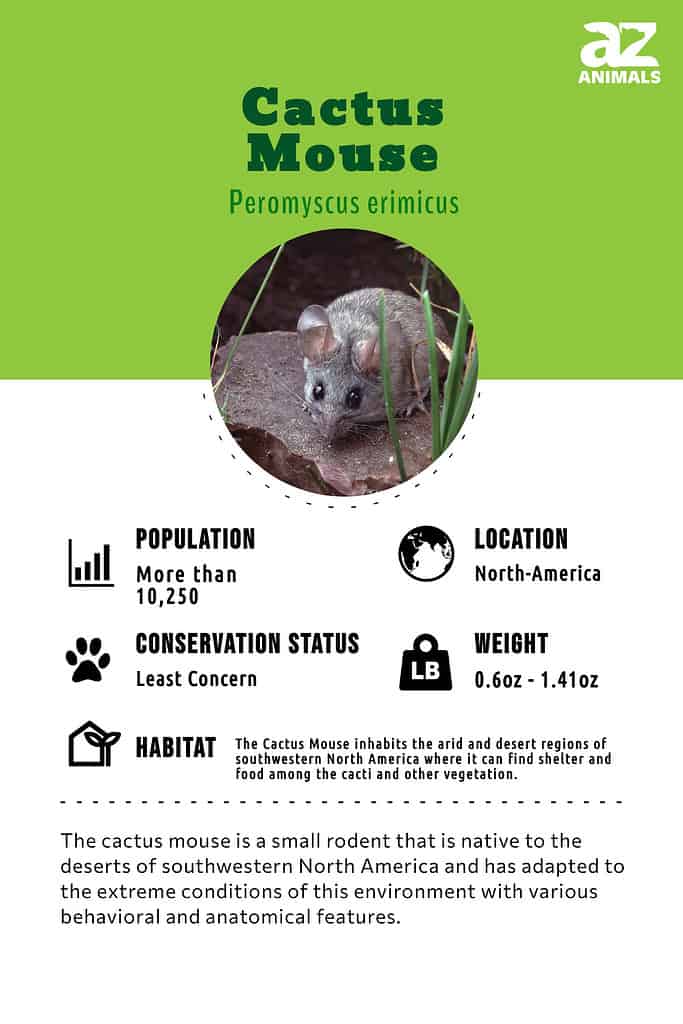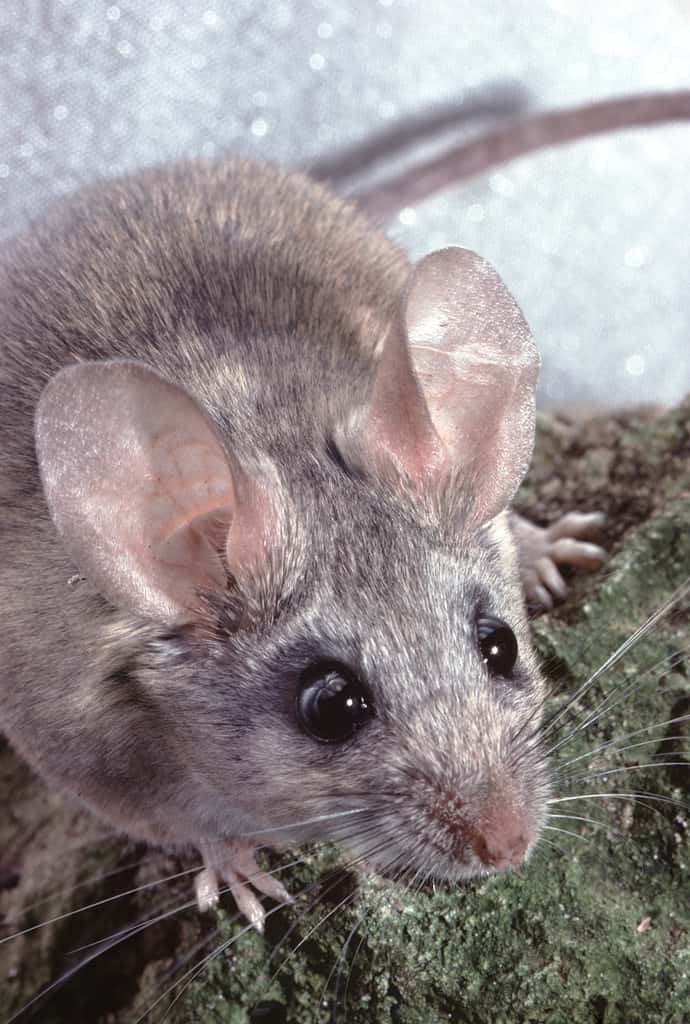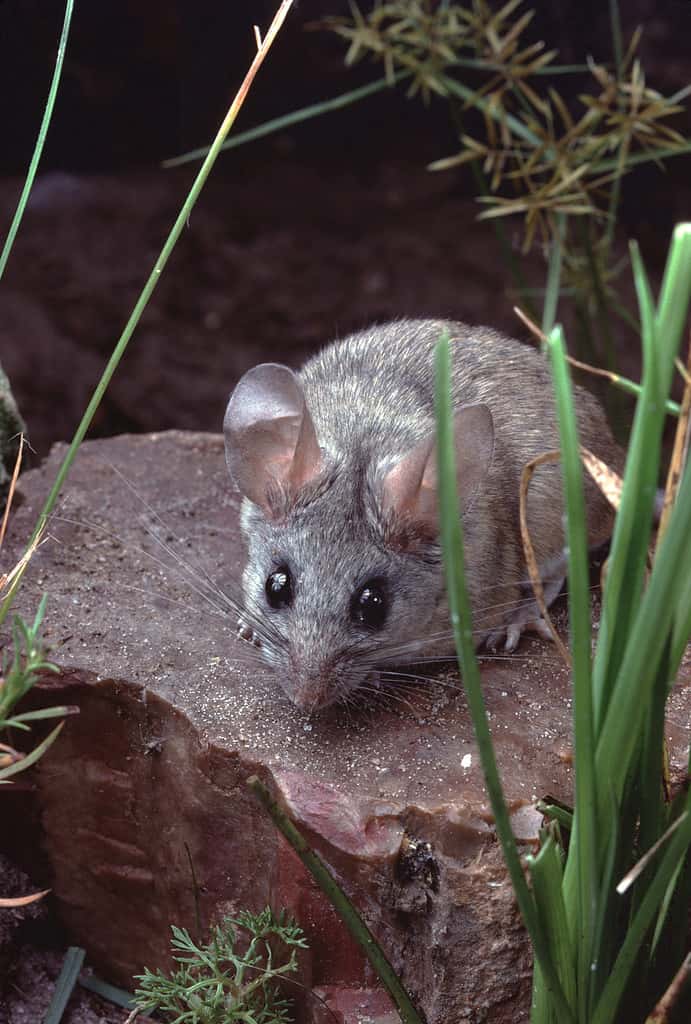Cactus Mouse
Peromyscus erimicus
In hot temperatures, they lower their metabolism and become inactive to reduce the amount of water they need to survive
Advertisement
Cactus Mouse Scientific Classification
- Kingdom
- Animalia
- Phylum
- Chordata
- Class
- Mammalia
- Order
- Rodentia
- Family
- Cricetidae
- Genus
- Peromyscus
- Scientific Name
- Peromyscus erimicus
Read our Complete Guide to Classification of Animals.
Cactus Mouse Conservation Status
Cactus Mouse Facts
- Prey
- insects
- Name Of Young
- Pinkie, kitten or pup
- Group Behavior
- Solitary
- Fun Fact
- In hot temperatures, they lower their metabolism and become inactive to reduce the amount of water they need to survive
- Biggest Threat
- predators
- Most Distinctive Feature
- extremely long tail
- Gestation Period
- 20-25 days
- Litter Size
- one to four
- Habitat
- Rocky deserts and shrublands
- Predators
- rattlesnake, owl, coyote, bobcat, hawk and fox
- Diet
- Omnivore
- Type
- rodent
- Common Name
- cactus mouse
- Number Of Species
- 1
- Location
- Southwestern U.S. and Northern Mexico
- Group
- solitary
Cactus Mouse Physical Characteristics
- Color
- Brown
- Grey
- White
- Skin Type
- Hair
- Top Speed
- 8 mph
- Lifespan
- one year
- Weight
- 0.6oz - 1.41oz
- Length
- 6.2in - 8.3in
- Age of Sexual Maturity
- two months
- Age of Weaning
- 25 days
View all of the Cactus Mouse images!

“Able to slow its metabolism during hot weather to reduce the amount of water it needs to survive.”
The cactus mouse of the southwestern United States and northern Mexico is a small rodent with large eyes, a pointed snout, large ears, hair over most of its body, and a lengthy tail. They are commonly confused with the North American deer mouse.
These nocturnal feeders have a shrill squeal and run an average of 13.1 kilometers per hour. They are also very good climbers.
The cactus mouse mostly forages for seeds and vegetation but will eat insects, too.
5 Incredible Cactus Mouse Facts!

Cactus Mouse (Peromyscus Eremicus) wildlife
©Liz Weber/Shutterstock.com
- They breed from January to October and have up to six litters per year.
- Scientists believe the mice are less active during a full moon.
- Can quickly run up rock walls and trees to escape predators.
- Eat succulent plants for hydration when they cannot find water.
- The mouse’s naked tail is usually longer than his body.
Scientific Name

Cactus Mouse (Peromyscus Eremicus)
©Liz Weber/Shutterstock.com
The cactus mouse, sometimes confused with the North American deer mouse, is in the class Mammalia. It is another member of the order Rodentia and family Cricetidae along with other common rodents like rats, hamsters, voles, and mice.
The cactus mouse has two subspecies, Peromyscus eremicus anthonyi with darker fur and Peromyscus eremicus eremicus with lighter fur. The mouse’s genus name Peromyscus is New Latin from Greek pēros, meaning “maimed” and myskos, meaning “small mouse.” Eremicus is from the Latin er- emicus, meaning “of the desert” or “lonely.”
Evolution and Origins
The cactus mouse, which is called Peromyscus eremicus, originates from the deserts located in the southwestern part of North America and showcases a set of traits that enable it to survive in this harsh setting.
Cactus mice possess both behavioral and anatomical adaptations that aid them in avoiding and dissipating heat. These adaptations include living a nocturnal lifestyle, having larger ears, and going into aestivation.
Around 65 million years ago, the shared ancestor of humans and mice was a mammal with rodent-like features that moved on the surface of the earth.
This mammal had to remain inconspicuous due to the presence of massive dinosaurs that dominated the earth during that time. These dinosaurs would have eaten any small mammal that they could catch.
Appearance and Behavior
The cactus mouse’s body only measures eighcm to ninecm without its tail. The tail is unusually long, adding another 10cm to 14cm. Proportionately, it is the longest tail for a mouse. Scientists believe the desert mouse’s tail length is related to body temperature regulation in desert climate extremes.
The cactus mouse can vary in color from the golden yellow of the subspecies Peromyscus eremicus ermeicus to a dark gray and almost black color. But most of the mice range between a dark gold ochre to cinnamon and gray. The fur on the mouse’s belly and the rest of its underside are generally white.
Its tail is usually not hairy, except at the very tip where it may have a slight tuft. The soles of their hind feet are also naked, an unusual trait among other Peromyscus species. Also different when compared to other members of their genus is the cactus mouse’s face and skull. As far as external features go, it has small ears.
The cactus mouse is sometimes called “aggressively solitary” except when mating. It is a nocturnal feeder that is shy yet excitable. They are fast runners, reaching speeds of an average of 13.1kmh. They use their speed to scamper or climb away from predators.
The mouse can become physically and mentally inactive during the day and can also control its metabolism in high temperatures and droughts. This enables them to go long periods without water. As solitary creatures, the mice maintain an average territory of 0.8 acres. Sometimes males’ territories overlap each other.
Habitat
The cactus mouse lives in the southwestern United States and northwestern Mexico, including several outlying Mexican islands. In the United States, it primarily dwells in southern California, southern Nevada, Arizona, southern New Mexico, and far west Texas.
They live in deserts, mostly in rocky regions and shrublands. Their fast running speed helps them scamper to safety from predators across the desert and up canyon walls or trees. Small rounded eyes help them see after dark as night feeders. Due to the heat, they typically sleep all day and conserve energy in their underground burrows or nests in bushes or under piles of rocks.
Predators & Threats
The cactus mouse thrives in its natural habitats in the southwestern United States and Mexico. Its conservation status with the IUCN is Least Concern.
What does the cactus mouse eat?
The nocturnal feeder generally eats seeds and vegetation. But as omnivores, they will also eat insects like spiders, centipedes, and millipedes. Favorite foods include fruits, grains, nuts, shrub blossoms, hackberry nutlets, mesquite beans, pine seeds, juniper seeds, leaves, trefoil, sage, grasses, and other green vegetation. During drought conditions, they will eat succulents as a source of water. They can even survive in fall and winter by eating poison oak! Like a squirrel, the mouse can hoard food.
What eats the cactus mouse?
The cactus mouse is a tasty food source for many predators including the rattlesnake, owl, coyote, bobcat, hawk, and fox. When startled by a predator, the mouse lets out a shrill squeal and runs at a speed of about 13.1 kmh. They can also climb quickly to safety, scampering up canyon walls, rock faces, and trees.
Reproduction, Babies, and Lifespan
Cactus mice reproduce from January to October for an average of 3.5 liters per year. But they can have as many as six litters in these 10 months. Scientists still have many questions about cactus mouse reproduction and mating rituals. But it is believed that females are sexually mature at 2 months old. It is unknown when males become sexually mature.
Litters of 1 to 4 offspring are born after 20 to 25 days of gestation. This is the same amount of time for gestation as for gerbils, but twice as long as for the opossum. Pinkies, kittens, or pups, as babies are called, are born without hair and with their eyes and ears closed.
At first deaf and blind, their ears open on day one of life, and their eyes open at 11 days to 15 days old. Babies nurse from their mother for about two weeks and molt for the first time at five weeks.
The average cactus mouse has a lifespan of about 1 year in the wild. But their lifespan increases to an average of 7.4 years in captivity.
Population
More than 10,250 population clusters of cactus mice have been counted in the southwestern United States and Mexico. But the population is likely many times larger, being both stable and of Least Concern by the IUCN.
View all 235 animals that start with CCactus Mouse FAQs (Frequently Asked Questions)
Are cactus mice carnivores, herbivores, or omnivores?
While cactus mice are nocturnal feeders that eat mostly plants, leaves, berries, fruit, seeds, nuts, and other vegetation, they also eat insects. This makes them omnivores. The insects playing an important part in their omnivorous diet include spiders, centipedes, and millipedes.
What eats a cactus mouse?
Cactus mice, like other mice dwelling in the desert, are prey to many predators. These predators include snakes, owls, hawks, bobcats, foxes, and coyotes.
What does the cactus mouse eat?
The nocturnal feeder cactus mouse eats insects like spiders, centipedes, and millipedes. But most of their daily diet is made up of fruits, grains, nuts, shrub blossoms, hackberry nutlets, mesquite beans, pine seeds, juniper seeds, leaves, trefoil, sage, grasses, and other green vegetation. They will also eat succulents for hydration and even poison oak when other foods are not as available in the fall and winter.
How big is a cactus mouse?
The cactus mouse is very small. But what it lacks in body size, it makes up for in tail length. Their bodies are only 8cm to 9cm in length and 0.6oz to 1.41oz in weight. But their hairless tails are 10cm to 14cm long.
How do cactus mice survive in the desert?
Cactus mice have many adaptations for surviving desert climate extremes and the predators who pursue them. They can beat extreme temperatures by slowing down their metabolism to require less water. They also go dormant during the day and come out at night for foraging. Other adaptations include their ability to run more than 13.1 kilometers per hour and climb fast up rock walls and trees. Even their tails help them survive, according to scientists who believe that the tail’s extra-long length relates to body temperature regulation.
Thank you for reading! Have some feedback for us? Contact the AZ Animals editorial team.
Sources
- Animal Diversity Web / Accessed November 11, 2021
- Wikipedia / Accessed November 11, 2021
- Lincoln Park Zoo / Accessed November 11, 2021
- sibr.com / Accessed November 11, 2021
- Arizona Independent News Network / Accessed November 11, 2021
- iNaturalist / Accessed November 11, 2021
- eol / Accessed November 11, 2021
- thewebsitteofeverything / Accessed November 11, 2021
- SBCSentinel / Accessed November 11, 2021
- JSTOR / Accessed November 11, 2021
- TTU Natural Science Research Labratory (1970) depts.ttu.edu/nsrl/mammals-of-texas-online-edition/Accounts_Rodentia/Peromyscus_eremicus.php / Accessed November 11, 2021
- IUCN Red List / Accessed November 11, 2021
- mentalfloss.com (1970) https://www.mentalfloss.com/article/24238/quick-10-10-gestation-periods-animal-kingdom Jump to top / Accessed November 11, 2021

















